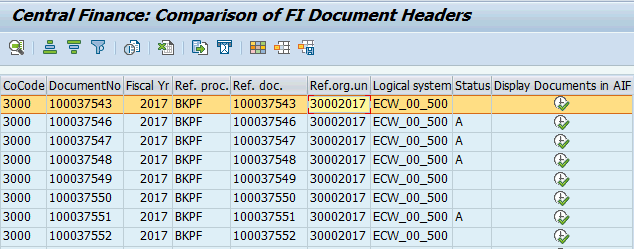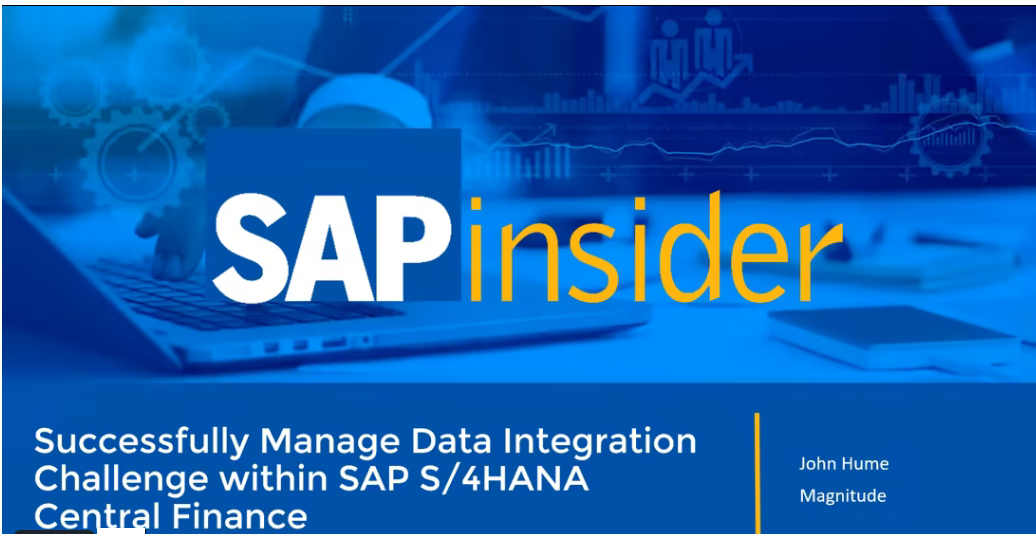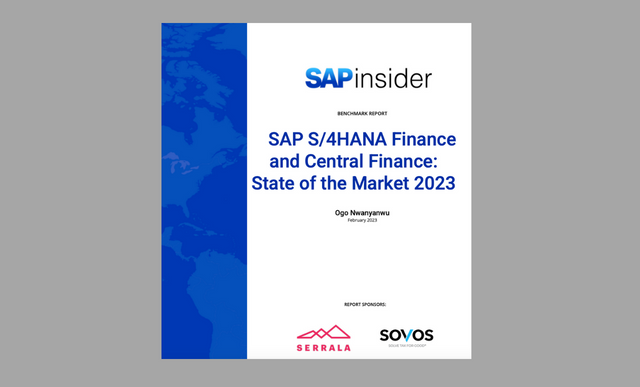Improve the Auditability of Your SAP S/4HANA for Central Finance Foundation Solution
Use the Real-Time Reconciliation Reports in SAP S/4HANA 1709 Enterprise Management
SAP S/4HANA for Central Finance foundation (Central Finance) is the least disruptive deployment option for SAP S/4HANA adoption in finance, especially for enterprises with a heterogeneous landscape consisting of multiple SAP and non-SAP finance transactional systems. Figure 1 provides a high-level overview of Central Finance in SAP S/4HANA along with its architecture.

Existing SAP or non-SAP finance transactional systems are untouched, and all financial postings — Financial Accounting (FI) and Managerial Accounting (CO) documents — in these systems are replicated in real time to the SAP S/4HANA-based Central Finance system. Three types of objects are replicated:
- FI postings (e.g., general ledger [G/L] postings and vendor and customer postings)
- CO-only postings made on secondary cost elements (e.g., manual reposting of costs, activity allocation, cost center assessment, and Profitability Analysis [CO-PA] assessment)
- Cost objects such as internal orders, production orders, and work breakdown structure (WBS) elements
The SAP Landscape Transformation Replication Server is used to collect data written to databases in the source systems. It feeds this data into the corresponding Central Finance accounting interface for three objects: FI postings, CO-only postings, and cost objects.
Business mapping functionality in the Central Finance system leveraging SAP Master Data Governance (MDG) is used to define a relationship between the identifier or code used in the source system for master data and customizing objects, with the identifier or code used in the Central Finance system. For example, cost center A in the source system is mapped to cost center B in the target system. Similarly, company code A in the source system is mapped to company code B in the target system.
SAP Application Interface Framework (AIF) installed in the Central Finance system is used for error analysis and correction of the documents replicated from source systems but not posted in the target Central Finance system.
For a detailed, step-by-step process for setting up Central Finance in SAP S/4HANA, click here. You can also refer to Central Finance FAQ Note 2184567.
Error Handling and Reconciliation in Central Finance
Since the primary use cases for Central Finance are for centralized financial reporting, real-time comparison reports between source systems and the Central Finance system are key to ensuring auditability and traceability of the documents and balances for internal stakeholders as well as external auditors. In this blog I provide an overview of how to accelerate this reconciliation process using the Central Finance comparison reports in combination with SAP AIF available with SAP S/4HANA 1709. Primarily, there are three levels of analysis done for comparison of the FI and CO documents replicated from source systems to Central Finance in these comparison reports:
• Level One: A comparison between FI and CO documents posted in the source system with Central Finance to check whether all relevant FI and CO documents have been replicated in Central Finance. This check is based on the number of documents in the source and Central Finance.
• Level Two: A comparison of the G/L balances for FI postings and cost element balances for secondary CO postings between source systems and Central Finance. This check is based on the balance per G/L account and cost element in the source and Central Finance.
• Level Three: A comparison of line items of FI and CO documents for G/L accounts in source system and Central Finance. This check is based on the amount for line items of each document and G/L account in source and Central Finance.
For an overview of these reports with transaction code and purpose, click here.
These comparison reports are available out of the box with the setup of Central Finance in SAP S/4HANA 1709, and no separate setup steps are required. However, for lower versions than SAP S/4HANA 1709 or for SAP S/4HANA Finance 1605, refer to SAP Note 2352483, which provides an overview of SAP Notes that are required to implement these comparison reports. I explain the three-level analysis that can be done for reconciliation using the comparison reports for FI documents and balances. The same logic can be applied for performing the reconciliation process for CO documents and balances.
Level-One Analysis
With this report you can do a technical reconciliation of documents between source and Central Finance systems to understand how many documents have been correctly replicated from the source system to the Central Finance system. To begin the level-one analysis, execute transaction code FINS_CFIN_DFV_FI_NUM to display the screen shown in Figure 2.
In the Source System field you must enter the logical system name of the source system maintained in IMG menu path Financial Accounting > Central Finance > General Settings > Define Logical System for Source and Central Finance systems in the Central Finance system. Only one source system at a time can be used in a report for comparison. All other parameters in the selection screen relate to the source system as shown in Figure 2.
Based on selection parameters the report selects FI documents from source system document header table BKPF and compares them with documents replicated in Central Finance from table BKPF. The document number of source system FI document is also stored in header field BKPF-BELNR_SENDER in the replicated document in Central Finance and is used as a basis for comparison. As shown in Figure 3, when the report is executed, the system displays the comparison based on five categories:
1. In Source System: This category shows you the number of documents that are posted in the source system for the criteria entered in Figure 2. In my example, the number is 348. No action is required on these from a reconciliation perspective.
2. In Central Finance System: This category shows you the number of documents that are posted in the Central Finance system for the corresponding documents in the source system. In my example, the number is 197. You can also click the display item details icon (shown in the third column of Figure 3) to drill down to list the replicated document numbers with corresponding source documents and amounts. Again, no action is required on these reports from a reconciliation perspective.
3. In AIF With Errors: This category informs you about the source system documents that have not been posted in Central Finance and are stuck with errors in AIF. This could be due to reasons such as missing business mapping or missing or incorrect configuration in Central Finance. In my example, this total is 129. These documents are the ones to be investigated and corrected. By clicking the execute icon shown in the third row and fourth column of Figure 3, you can view the errors with reasons. You also can display each individual document only in AIF by clicking the display details icon first and then clicking the execute icon under the Display Documents in AIF column for each individual document in the rows shown in Figure 4.
After you click the execute icon in the Display Documents in AIF column for an individual document, you can view the error details in AIF in the Log Messages section of the next screen (Figure 5) along with details of the accounting document posting data from the source system. After you correct the errors by maintaining the missing mapping or configuration, you can restart the message in AIF by clicking the execute icon highlighted in Figure 5. The document is then moved to a category named “In Central Finance system” if it is successfully posted in Central Finance.
4. In AIF Without Errors: This category shows you the source system documents that are transferred, but that should not be posted in Central Finance. Examples are cancelled documents owing to duplicates resulting from parallel job processing and foreign currency valuation postings for a currency type not set up in Central Finance.
5. Document not in Central Finance: This category shows you the source system documents that are neither posted in Central Finance nor found in AIF. Examples include jobs in the Landscape Transformation Replication Server system for replication that are not running, a system that has crashed, and a company code that is not active in replication in the source system configuration. In such cases after you identify and correct the root cause in the source system configuration or the Landscape Transformation Replication Server system, these documents need to be replicated from the source to Central Finance.
Level-Two Analysis
After the level-one analysis has been done and the missing documents have been identified and corrected, level-two analysis can be done for comparison of G/L balances between the source and target systems with this report for identification and correction of differences if any. To begin the level-two analysis, execute transaction code FINS_CFIN_DFV_FI_BALANCE to display the screen shown in Figure 6.
For the criteria specified, this report extracts the G/L balances from the totals tables in source systems (GLT0 for the classic G/L and FALGLFLEXT for the SAP General Ledger) and compares them by summing up the values for the corresponding entries in Central Finance in table ACDOCA. If the source system is on the classic G/L and no ledger is specified, then the comparison of balances is done with the leading ledger in the Central Finance system. The comparison can be done in company code currency, or if the company code currencies are different, then the comparison can be done in transaction currency. Note also that activating the Show Errors Only check box shown in Figure 6 instructs the system to display only the G/L account balances with differences in the report.
As shown in Figure 7, the report shows the details of source G/L accounts with debit totals, credit totals, and balances compared against the target G/L account with the same details.
The difference amounts are shown in the balance of source and target with a description of the reason for difference, primarily into these two categories:
- Different totals: G/L balances are different between the source and target. This difference could be the result of not having all the source accounting documents transferred to Central Finance. These are shown in red. To drill down to individual documents causing the difference, double-click the relevant line item in the report. Based on further analysis of the error in AIF for the relevant document, you can make corrections if they are not done already as part of level-one analysis.
- Balances match. Documents missing in target: This is also shown in red in the report. In this case the balances match for G/L accounts, but accounting documents are missing in Central Finance. The possible reason could be if the debit and credit G/L accounts are the same in the posting in source system resulting in zero impact on the G/L balance, but the document is not replicated in Central Finance for some reason. This can also be analyzed further by double-clicking the relevant line item in the report and carrying out further analysis in AIF if required.
Level-Three Analysis
After the level-one and level-two analyses have been done for reconciliation of documents and G/L balances, you can execute this report to do the comparison of debit and credit amounts of each line item for selected G/L accounts between source and Central Finance systems.
To begin the level-three analysis, execute transaction code FINS_CFIN_DFV_FI_DOC to display the screen shown in Figure 8.
For the criteria specified, this report extracts the line-item details from the BSEG and BKPF tables in the source systems and compares them with entries in the ACDOCA table in Central Finance. The comparison can be done in company code currency, or if the company code currencies are different, then the comparison can be done in transaction currency. Again, note that activating the Show Errors Only check box, as shown in Figure 8, instructs the system to display only the G/L account line items with differences in the report, as shown in Figure 9.
As shown in Figure 9, for each source document and G/L account the report shows a comparison of each of the debit and credit line item amounts with corresponding debit and credit line items in the Central Finance system. The differences are shown in red with a description and are primarily categorized into three areas:
• Documents not in Central Finance: The source system documents are not replicated in Central Finance and therefore are also not visible in AIF. Most of these errors should already be resolved in the level-one analysis of document headers with report FINS_CFIN_DFV_FI_NUM. Some of the reasons could be that jobs in the Landscape Transformation Replication Server for replication are not running, that the system has crashed, or that the company code is not active in replication in the source system configuration.
• In AIF With Errors: The source system document has been replicated to Central Finance, but is not posted and is stuck with an error in AIF. Possible reasons could be missing business mapping or missing or incorrect configuration in the Central Finance system. Most of these errors should also already have been resolved in the level-one analysis of document headers with report FINS_CFIN_DFV_FI_NUM.
• Reference to sender document not unique: The same source system document number reference is available in more than one document posted in Central Finance. Possible reasons could be duplicate posting in Central Finance for the same source document due to parallel processing jobs. One of the documents in Central Finance needs to be cancelled in this case
Similar level-three analysis for reconciliation can also be done for CO documents, line items, and balances between the source system and Central Finance using the CO reconciliation reports.
Tips
Here are four tips to consider:
1. All these reconciliation reports for Central Finance are based on documents posted in the source system. Therefore, if a document is posted in Central Finance directly and not replicated from the source system, it is not captured in these reconciliation reports. However, such postings can be easily identified from GL Account Line Item Display (transaction code FBL3H) or document list (transaction code FB03) in the Central Finance system since the field Sender Document Number (BKPF-BELNR_SENDER) will be blank for such postings.
2. It is better to restrict the selection criteria in a report for improved performance and to have better control on resolution of errors for reconciliation.
3. To enhance the logic for the reconciliation reports Business Add-In (BAdI): Enhance Processing and Output of Reconciliation Reports (BAdI_FINS_CFIN_DFV) is available under IMG menu path Financial Accounting > Central Finance > BAdIs: Central Finance.
4. The reconciliation reports for comparison of FI and CO document headers can also be monitored automatically through Business Process Monitoring (BPMON) functionality in SAP Solution Manager, with automated alerts and notifications. Refer to the Central Finance administrators guide for more details.















